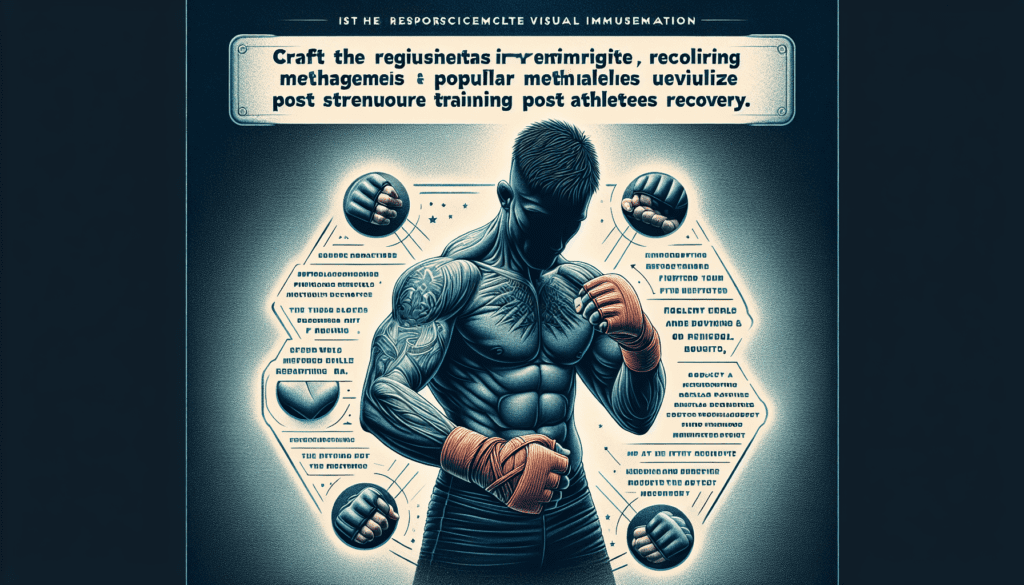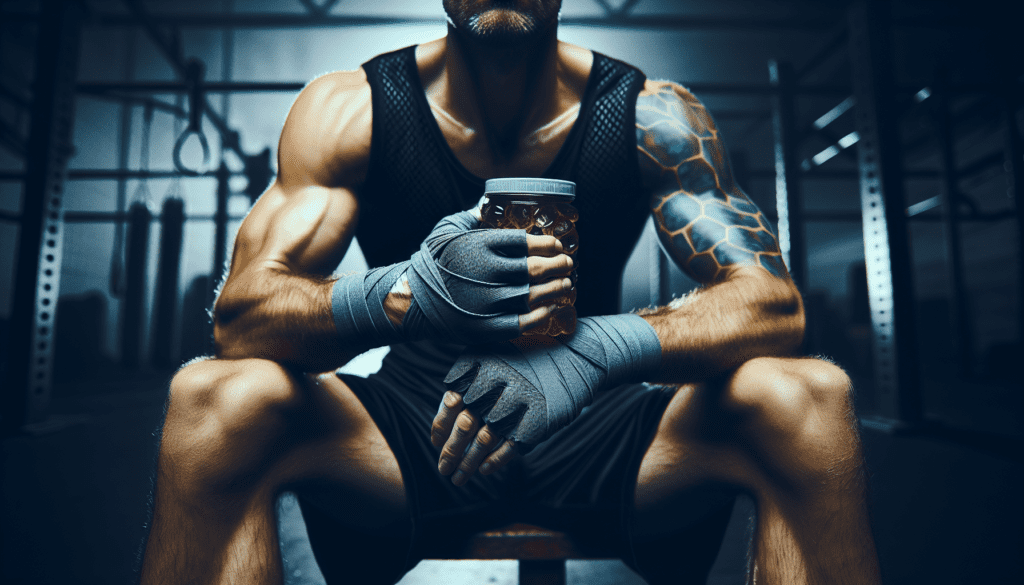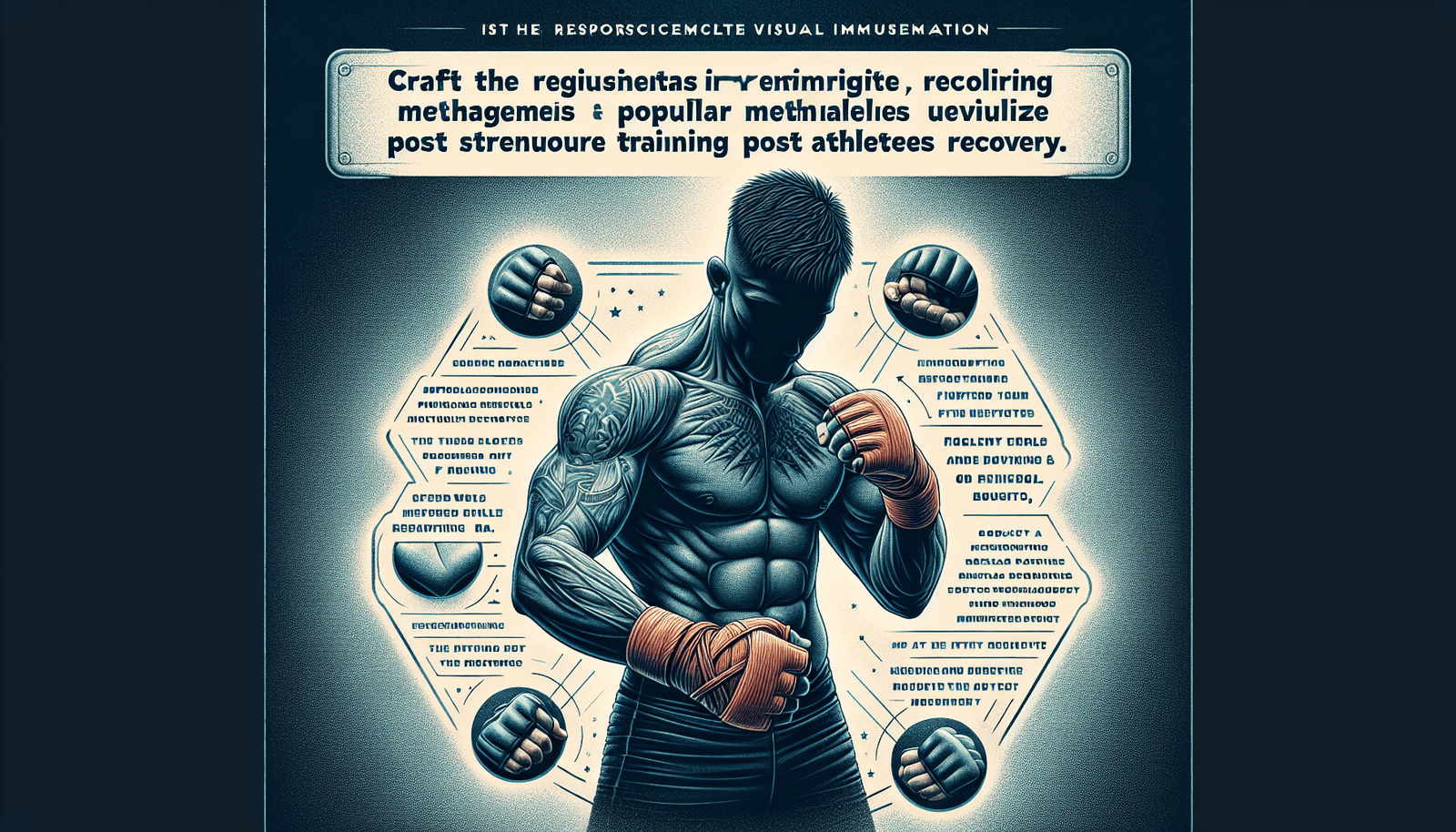If you’re an MMA fighter looking to maximize your recovery and performance, it’s essential to have effective recovery modalities in your training routine. With the physical demands and intensity of MMA training, giving your body the proper tools to recover is crucial. In this article, we’ll explore the most popular recovery modalities used by MMA fighters, enabling you to optimize your training and achieve peak performance in the octagon. From cryotherapy to active recovery techniques, we’ll cover everything you need to know to keep your body in top shape and ready for your next fight.

Cryotherapy
Cryotherapy is a popular recovery modality utilized by many MMA fighters. It involves exposing the body to extremely cold temperatures for a short period of time. There are two main types of cryotherapy: whole body cryotherapy and localized cryotherapy.
Whole Body Cryotherapy
Whole body cryotherapy involves entering a cryotherapy chamber where the temperature drops to as low as -200 degrees Fahrenheit. You spend only a few minutes inside the chamber, and the extreme cold stimulates the body’s natural healing process. This therapy has been shown to reduce inflammation, alleviate muscle soreness, and enhance recovery.
Localized Cryotherapy
Localized cryotherapy targets specific areas of the body that need attention. Instead of entering a cryotherapy chamber, a focused stream of cold air or ice is applied directly to the affected area. This method is effective for treating injuries or sore muscles in a targeted manner. It can help reduce inflammation and promote healing.
Cryotherapy Chambers
Cryotherapy chambers are specifically designed to provide whole body cryotherapy. The chambers use liquid nitrogen or refrigerated cold air to lower the temperature inside. Many MMA fighters find cryotherapy chambers to be an efficient and effective way to support their recovery process. The extreme cold temperature can help reduce inflammation, decrease muscle soreness, and improve overall well-being.
Compression Therapy
Compression therapy is another recovery modality that is widely used among MMA fighters. It involves applying pressure to specific parts of the body through the use of compression garments. There are several types of compression therapy, including compression boots, compression sleeves, and compression pants.
Compression Boots
Compression boots are specially designed boots that cover the legs and feet and apply compression to these areas. The compression helps enhance blood flow, reduce muscle soreness, and speed up the recovery process. MMA fighters often use compression boots after intense training sessions or fights to promote faster recovery and prevent muscle fatigue.
Compression Sleeves
Compression sleeves are worn on the arms and provide targeted compression to the muscles. They help improve circulation, reduce muscle vibration, and alleviate soreness. MMA fighters often wear compression sleeves during training sessions or after fights to support their recovery and enhance performance.
Compression Pants
Compression pants are worn on the lower body and provide compression to the muscles in the thighs, hips, and glutes. The compression helps increase blood flow, reduce muscle fatigue, and promote recovery. MMA fighters often wear compression pants during training or after intense workouts to support their muscles and aid in their recovery process.
Massage Therapy
Massage therapy is a popular recovery modality that has been used for centuries to promote relaxation and alleviate muscle tension. There are several types of massage therapy that MMA fighters commonly use, including sports massage, deep tissue massage, and trigger point therapy.
Sports Massage
Sports massage is a specialized type of massage therapy that targets the muscles and soft tissues used in athletic activities. It helps improve flexibility, reduce muscle soreness, and enhance recovery. MMA fighters often receive sports massages before or after training sessions or fights to prepare their bodies and promote optimal performance.
Deep Tissue Massage
Deep tissue massage focuses on the deeper layers of muscles and connective tissues. It uses deep, slow strokes and intense pressure to alleviate chronic muscle tension and promote healing. MMA fighters often use deep tissue massage to relieve muscle soreness and promote recovery after intense training or fights.
Trigger Point Therapy
Trigger point therapy is a technique that involves applying pressure to specific points in the muscles to alleviate pain and release tension. This therapy targets trigger points, which are tight knots in the muscles that can cause pain and restrict movement. MMA fighters often seek trigger point therapy to address specific areas of tension or discomfort and promote muscle relaxation and recovery.
Hot and Cold Therapy
Hot and cold therapy is a simple yet effective recovery modality that can be easily incorporated into an MMA fighter’s routine. It involves exposing the body to alternating hot and cold temperatures, usually through the use of ice baths, hot baths, or contrast therapy.
Ice Baths
Ice baths, also known as cold water immersion, involve submerging the body in cold water (usually around 50-59 degrees Fahrenheit) for a short period of time. This therapy helps reduce inflammation, muscle soreness, and swelling. MMA fighters often use ice baths after intense workouts or fights to promote faster recovery and reduce muscle fatigue.
Hot Baths
Hot baths involve soaking the body in warm water (typically around 100-104 degrees Fahrenheit) for relaxation and muscle soothing. The heat helps increase blood flow, relax muscles, and promote a sense of relaxation and well-being. MMA fighters often use hot baths as a form of active recovery or as a way to unwind after intense training sessions.
Contrast Therapy
Contrast therapy involves alternating between hot and cold treatments to stimulate circulation and promote healing. This can be done by combining hot and cold baths or by using hot and cold packs on targeted areas of the body. The contrast of temperatures helps enhance blood flow, reduce inflammation, and speed up the recovery process. MMA fighters often incorporate contrast therapy into their recovery routine to support muscle recovery and reduce post-workout soreness.

Foam Rolling
Foam rolling, also known as self-myofascial release, is a recovery modality that involves using a foam roller to apply pressure to specific areas of the body. This self-massage technique helps release muscle tension, improve flexibility, and enhance blood flow.
Self-Myofascial Release
Self-myofascial release is achieved by using a foam roller or other similar tools to apply pressure to tight or knotted areas of muscle tissue. By rolling the targeted muscle group over the foam roller, you can break up adhesions and release muscle tension. This can help reduce muscle soreness and increase range of motion, making it an effective recovery tool for MMA fighters.
Muscle Relaxation
Foam rolling promotes muscle relaxation by triggering the relaxation response in the body. The pressure applied by the foam roller stimulates the sensory receptors in the muscles, which sends signals to the brain to release tension. This can help calm the nervous system, reduce muscle tightness, and promote overall relaxation and well-being.
Improved Blood Flow
Foam rolling helps improve blood flow to the muscles, which is essential for optimal recovery. By applying pressure to the muscle tissue, you can increase circulation and enhance the delivery of oxygen and nutrients to the muscles. This can aid in muscle repair and reduce recovery time for MMA fighters.
Stretching
Stretching is a fundamental component of any recovery routine for MMA fighters. It helps improve flexibility, reduce muscle stiffness, and prevent injuries. There are three main types of stretching that are commonly used: static stretching, dynamic stretching, and PNF stretching.
Static Stretching
Static stretching involves holding a stretch for a period of time without any movement. This type of stretching helps increase muscle length, improve flexibility, and reduce muscle tension. MMA fighters often use static stretching as part of their cool-down routine to aid in muscle recovery and prevent muscle imbalances.
Dynamic Stretching
Dynamic stretching involves moving through a range of motion in a controlled manner. Unlike static stretching, dynamic stretching uses the muscles’ natural elasticity to stretch and warm up the muscles. This type of stretching helps improve joint flexibility, enhance muscle coordination, and prepare the body for physical activity. MMA fighters often incorporate dynamic stretching into their warm-up routine before training or fights.
PNF Stretching
PNF (proprioceptive neuromuscular facilitation) stretching is a technique that involves a combination of stretching and contraction of the muscles. It typically involves a partner-assisted stretching method where one person holds a stretch while the other person pushes against the resistance. PNF stretching helps improve flexibility, increase range of motion, and promote muscle relaxation. MMA fighters often incorporate PNF stretching into their flexibility training to enhance their overall performance and prevent injuries.
Electrical Stimulation
Electrical stimulation is a recovery modality that involves the use of electrical currents to stimulate the muscles. It can help relax muscles, reduce pain, and enhance muscle recovery. There are two main types of electrical stimulation used in MMA recovery: transcutaneous electrical nerve stimulation (TENS) and neuromuscular electrical stimulation (NMES).
Transcutaneous Electrical Nerve Stimulation (TENS)
Transcutaneous electrical nerve stimulation (TENS) involves the use of low-frequency electrical currents to relieve pain. The electrical currents are applied through electrodes placed on the skin near the area of pain or discomfort. TENS therapy helps stimulate the nerves and release endorphins, which are natural pain-relieving chemicals produced by the body. MMA fighters often use TENS therapy to alleviate muscle soreness and promote recovery.
Neuromuscular Electrical Stimulation (NMES)
Neuromuscular electrical stimulation (NMES) involves the use of electrical currents to stimulate muscle contractions. It helps activate the muscles and increase blood flow to the area, which can aid in muscle recovery and strength gains. MMA fighters often use NMES as a supplement to their training to enhance muscle activation, prevent muscle atrophy, and promote overall muscle recovery.
Floatation Therapy
Floatation therapy, also known as sensory deprivation therapy, is a unique recovery modality that involves floating in a sensory deprivation tank filled with saltwater. This therapy provides a weightless and calm environment, offering various benefits for MMA fighters.
Reduced Gravity
Floatation therapy allows the body to experience a weightless environment, relieving pressure on the joints and muscles. This can help alleviate muscle soreness, reduce inflammation, and promote relaxation. MMA fighters often use floatation therapy to decompress their bodies after intense training or fights, giving their muscles and joints a break from the constant impact and stress.
Sensory Deprivation
Floatation therapy provides a sensory-deprived environment by eliminating external stimuli such as light, sound, and gravity. This allows the mind to enter a state of deep relaxation and promotes mental clarity. MMA fighters often use floatation therapy to reduce stress, improve mental focus, and enhance overall well-being.
Stress Reduction
Floatation therapy has been shown to effectively reduce stress and anxiety. The quiet and peaceful environment of the floatation tank helps the body release endorphins, which are natural stress-relieving chemicals. MMA fighters often experience high levels of stress before and after fights, so incorporating floatation therapy into their recovery routine can help them manage stress and promote a sense of calm and relaxation.
Hyperbaric Oxygen Therapy
Hyperbaric oxygen therapy (HBOT) is a recovery modality that involves breathing in pure oxygen in a pressurized chamber. This therapy promotes increased oxygen supply to the body, which can enhance recovery and healing.
Increased Oxygen Supply
Hyperbaric oxygen therapy increases the amount of oxygen delivered to the body at a cellular level. The increased oxygen supply promotes cellular repair, reduces inflammation, and aids in tissue regeneration. MMA fighters often use HBOT to accelerate their recovery process after intense training or injuries.
Accelerated Healing
The increased oxygen supply in hyperbaric oxygen therapy helps stimulate the production of new blood vessels, promote the growth of new tissue, and enhance the body’s natural healing mechanisms. MMA fighters often use HBOT to speed up their recovery time from injuries, allowing them to get back to training and fighting sooner.
Reduced Swelling
Hyperbaric oxygen therapy has been shown to reduce swelling and edema by improving the circulation of oxygen-rich blood to the affected area. This can help alleviate pain and promote faster recovery. MMA fighters often use HBOT to address swelling and inflammation caused by intense training sessions or injuries, allowing them to recover more effectively.
Nutrition and Hydration
Proper nutrition and hydration play a crucial role in the recovery process for MMA fighters. It is important to maintain a proper macronutrient balance, ensure adequate protein intake, and implement hydration strategies.
Proper Macronutrient Balance
Maintaining a proper macronutrient balance is essential for muscle recovery and overall health. MMA fighters need to consume an appropriate balance of carbohydrates, proteins, and fats to support their training and recovery. Carbohydrates provide energy, proteins aid in muscle repair, and healthy fats support hormone production. Proper macronutrient balance ensures that MMA fighters have the necessary nutrients to recover effectively.
Adequate Protein Intake
Protein is crucial for muscle repair and growth. MMA fighters need to consume an adequate amount of protein to support their intense training and promote muscle recovery. Good sources of protein include lean meats, fish, poultry, dairy products, and plant-based protein sources. Adequate protein intake helps rebuild damaged muscle tissue and promotes optimal recovery.
Hydration Strategies
Proper hydration is essential for optimal performance and recovery. MMA fighters need to stay well-hydrated before, during, and after training sessions or fights. Dehydration can lead to decreased performance, muscle cramps, and impaired recovery. MMA fighters should develop hydration strategies that include drinking enough water throughout the day and replenishing electrolytes lost through sweat. Hydration supports optimal muscle function, nutrient delivery, and overall recovery.
In conclusion, MMA fighters utilize various recovery modalities to support their physical and mental well-being. Cryotherapy, compression therapy, massage therapy, hot and cold therapy, foam rolling, stretching, electrical stimulation, floatation therapy, hyperbaric oxygen therapy, and proper nutrition and hydration all play important roles in an MMA fighter’s recovery routine. By incorporating these techniques into their training regimen, MMA fighters can enhance their recovery, prevent injuries, and optimize their performance in the octagon.

